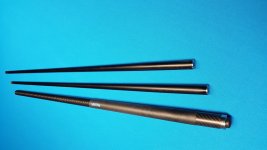Thanks.
I think a low-squirt Revo squirts less than a normal-squirt maple shaft. Not sure what bridge length has to do with it...?
pj
chgo
Patrick,
You brought up bridge length. You were saying that due the longer natural pivot point on an LD shaft, that when using a bridge of shorter length than that the shaft would actually be less forgiving to stroke errors. Assuming as you later said here that for essentially all bridge lengths the LD shaft will have lower squirt, can you pull that together with your previous comment about being less forgiving?
When I say "forgiving", I'm talking about the concept that if one accidentally hits slightly to the left or right of center by mistake when aiming for center, the resulting squirt on a standard shaft may be enough to miss the ball, whereas the reduced squirt on an LD shaft may keep the cueball closer to the intended target line and hence possibly still make the ball in spite of the curing error.
Thoughts?
KMRUNOUT
Sent from my iPhone using AzBilliards Forums


